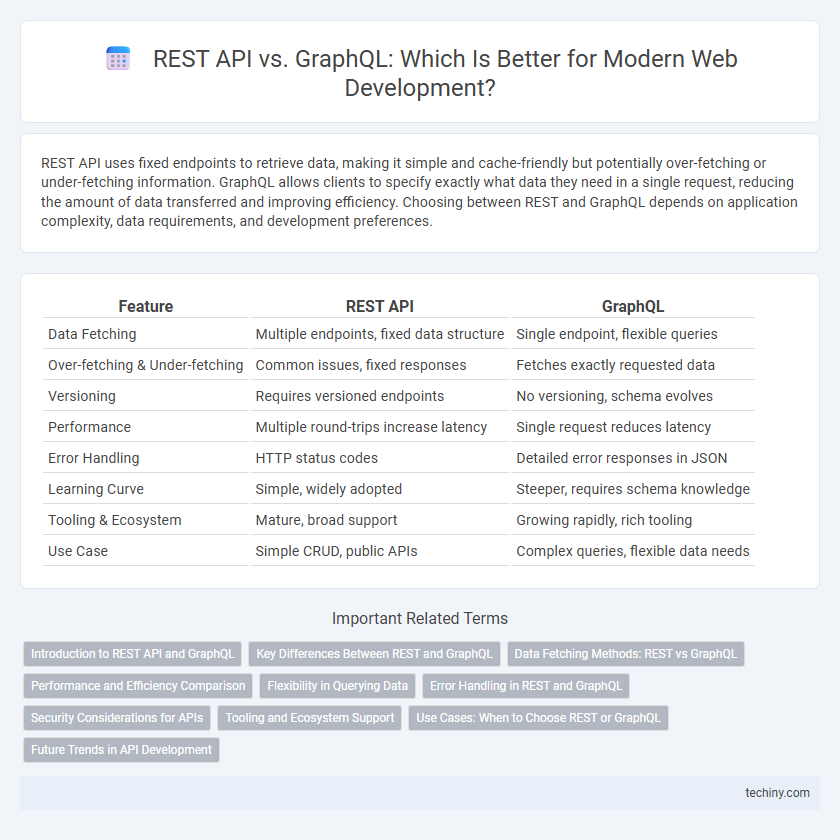REST API uses fixed endpoints to retrieve data, making it simple and cache-friendly but potentially over-fetching or under-fetching information. GraphQL allows clients to specify exactly what data they need in a single request, reducing the amount of data transferred and improving efficiency. Choosing between REST and GraphQL depends on application complexity, data requirements, and development preferences.
Table of Comparison
| Feature | REST API | GraphQL |
|---|---|---|
| Data Fetching | Multiple endpoints, fixed data structure | Single endpoint, flexible queries |
| Over-fetching & Under-fetching | Common issues, fixed responses | Fetches exactly requested data |
| Versioning | Requires versioned endpoints | No versioning, schema evolves |
| Performance | Multiple round-trips increase latency | Single request reduces latency |
| Error Handling | HTTP status codes | Detailed error responses in JSON |
| Learning Curve | Simple, widely adopted | Steeper, requires schema knowledge |
| Tooling & Ecosystem | Mature, broad support | Growing rapidly, rich tooling |
| Use Case | Simple CRUD, public APIs | Complex queries, flexible data needs |
Introduction to REST API and GraphQL
REST API is a widely adopted architectural style for designing networked applications, relying on stateless communication and standard HTTP methods such as GET, POST, PUT, and DELETE to perform operations on resources represented by URLs. GraphQL is a query language and runtime developed by Facebook that enables clients to request exactly the data they need, minimizing over-fetching and under-fetching by allowing a single endpoint to access multiple resources in a flexible, hierarchical structure. Both REST API and GraphQL serve as powerful tools for building client-server interactions, with REST emphasizing simplicity and resource-based design, while GraphQL prioritizes efficiency and customized data queries.
Key Differences Between REST and GraphQL
REST APIs use fixed endpoints and standard HTTP methods to retrieve predefined data structures, while GraphQL enables clients to request exactly the data they need through a single endpoint. REST commonly results in over-fetching or under-fetching of data, whereas GraphQL provides precise querying capabilities that optimize data transfer. REST typically follows a stateless protocol with multiple round trips, whereas GraphQL consolidates data requirements and reduces network requests, enhancing performance.
Data Fetching Methods: REST vs GraphQL
REST APIs rely on multiple endpoints to fetch fixed data structures, often leading to over-fetching or under-fetching of information. GraphQL uses a single endpoint where clients specify exactly what data they need, optimizing bandwidth and improving performance. This flexibility in data retrieval makes GraphQL more efficient for complex and dynamic querying compared to REST.
Performance and Efficiency Comparison
REST API relies on multiple endpoints for data retrieval, which can lead to over-fetching or under-fetching of data, impacting performance negatively. GraphQL optimizes efficiency by allowing clients to request exactly the data they need in a single query, reducing payload size and improving response times. This precise data fetching mechanism enhances performance, especially in applications with complex relational data and varying client requirements.
Flexibility in Querying Data
REST API offers fixed endpoints with predefined data responses, limiting flexibility when clients need specific or variable data structures. GraphQL provides a powerful query language that allows clients to request exactly the data they need in a single request, reducing over-fetching and under-fetching issues. This flexibility enhances performance and adaptability in modern web applications, enabling efficient data retrieval tailored to diverse client requirements.
Error Handling in REST and GraphQL
Error handling in REST APIs typically relies on standard HTTP status codes such as 404 for resource not found, 500 for server errors, and 400 for bad requests, providing a straightforward but sometimes limited way to communicate issues. GraphQL, in contrast, returns detailed error objects within the response body alongside partial or complete data, enabling more granular and precise error reporting for complex queries. This enhanced error visibility in GraphQL facilitates better client-side error handling and debugging compared to REST's status code-based approach.
Security Considerations for APIs
REST APIs typically rely on standard HTTP methods and status codes, making it easier to implement well-established security practices such as OAuth2 and JWT authentication. GraphQL, while flexible in querying, requires careful validation and rate limiting to prevent over-fetching or denial-of-service attacks due to its complex query structure. Both API types benefit from enforcing strict access controls, input validation, and use of encryption like TLS to safeguard data transmission and prevent unauthorized access.
Tooling and Ecosystem Support
REST API benefits from a mature ecosystem with widespread tooling such as Postman, Swagger, and API Gateway integrations that simplify testing, documentation, and deployment. GraphQL offers a growing set of specialized tools like Apollo Client, GraphiQL, and Relay, which enhance real-time data querying, schema introspection, and client-side state management. Both technologies boast active community support, but REST's established presence ensures broader compatibility with legacy systems and enterprise applications.
Use Cases: When to Choose REST or GraphQL
REST API suits applications requiring simple, stateless CRUD operations with well-defined endpoints and standardized HTTP methods. GraphQL excels in scenarios needing flexible queries, allowing clients to fetch precisely the data they need, which optimizes performance and reduces over-fetching or under-fetching. Complex applications with multiple data sources or rapidly evolving front-end requirements benefit from GraphQL's schema and query capabilities, while REST remains ideal for straightforward, cacheable, and widely supported APIs.
Future Trends in API Development
REST API and GraphQL are shaping the future of API development by addressing different needs in data fetching and efficiency. GraphQL's flexible query capabilities reduce over-fetching and under-fetching, making it ideal for complex, evolving frontend requirements, while REST remains widely adopted due to its simplicity and robust caching mechanisms. Emerging trends indicate a shift towards hybrid approaches combining GraphQL's flexibility with RESTful principles to optimize performance and developer experience in scalable web applications.
REST API vs GraphQL Infographic

 techiny.com
techiny.com